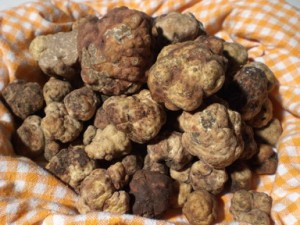In Italia e in Francia è in fase di sperimentazione la coltivazione dei tartufi, ma con risultati ancor scarsi.
Il tartufo è una delizia selvaggia, che viene raccolta direttamente dalla terra, e in passato l’utilizzo di maialini nella ricerca del tartufo aveva provocato disastrosi effetti di disboscamento. Dagli anni’40 infatti, in Italia è stato vietata la raccolta con i maiali, per sostituirli con dei cani segugi debitamente addestrati, nel rispetto della flora e dl suolo, in perfetto stile bio.
I tartufi sono in realtà dei funghi, descritti nei testi antichi come il cibo delle streghe, e dunque velenosi e dagli influssi demoniaci. Oggi il tartufo è invece tra le più pregiate prelibatezze gastronomiche (di alto valore economico in quanto rari): risotti, carpacci, persino nelle grappe, il tartufo possiede un gusto intenso e inconfondibile. È inoltre ricco di importanti principi nutritivi, con solo 31 kcal per 100g. Il tartufo possiede infatti ottime qualità antianemiche e rimineralizzanti, grazie all’alta concentrazione di sali minerali e fibre.
Il tartufo nasconderebbe, inoltre, delle proprietà afrodisiache, grazie ad effluvi che provocherebbero un momentaneo stato di benessere psico-emotivo, tale da indurre una maggiore apertura e predisposizione verso il sesso opposto.
Inoltre, un consumo moderato e occasionale può apportare effetti benefici sulla digestione, ma, ATTENZIONE: un abuso smodato può causare un sovraffaticamento per fegato e stomaco (è infatti sconsigliato ai pazienti che soffrano di epatopatie), provocando dei disturbi.
Tuttavia ne basta davvero una minima quantità per insaporire meravigliosamente un piatto: il tartufo non viene commercializzato crudo e intero, ma è facilmente reperibile in bustine sottovuoto, sottolio, liofilizzato in polvere, persino in dolci e gelati preconfezionati, riuscendo a preservarne le qualità nutritive.
In Italy and France in experimentation the cultivation of truffles, but the results were still insufficient.
The truffle is a treat wild, which is collected directly from the earth, and in the past the use of pigs to find truffles had caused disastrous effects of deforestation. Since 40s in fact, in Italy it was forbidden the harvest with the pigs, to replace them with properly trained hounds dogs, in respect of the flora and of the ground, in perfect bio style.
Truffles are actually mushrooms, described in ancient texts as the food of witches, and therefore poisonous and with demonic influences. Today, however, the truffle is one of the most valuable culinary delights (of a high economic value as rare): risotto, carpaccio and even in grappa, truffles have an intense and unmistakable flavor. It is also rich in important nutrients, with only 31 kcal per 100g. Truffle has in fact good anti-anemic and re-mineralizing qualities, thanks to the high concentration of mineral salts and fiber.
The truffle would hide also aphrodisiac properties, thanks to perfumes that would cause a momentary state of psycho-emotional well-being, such as to induce greater openness and susceptibility to the opposite sex.
In addition, a consumer can make occasional and moderate beneficial effects on digestion, but WARNING: an excessive abuse can cause a liver and stomach weariness (it is not recommended for patients who suffer from liver disease), causing interference.
However it really suffices just small amount to flavor a dish wonderfully: the truffle isn’t sold raw and whole, but it readily available in vacuum bags, oil, freeze-dried powder, even in desserts and ice cream prepackaged, managing to preserve its nutritional value.
En Italie et en France il est en phase d’expérimentation la culture des truffes, mais avec des résultats encore insuffisants.
La truffe est un délice sauvage, que vient récolte directement de la terre, et en passé l’utilisation de porcs dans la recherche de la truffe avait provoqué désastreux effets de déboisement. Depuis les ans 40 en effet, en Italie la récolte avec les porcs a été interdite, pour les remplacer avec des chiens limiers dressés, dans le respect de la flore et du sol, en parfait style bio.
Les truffes sont en réalité des champignons, décrit dans les textes anciens comme la nourriture des sorcières, et donc toxiques et avec des influences démoniaques. Aujourd’hui la truffe est par contre est considérée exquise (de haute valeur économique puisque rares): risotti, carpacci, même dans les grappes, la truffe possède un goût intense et unique. Il est riche en outre d’importants substances nutritives, avec seul 31 kcals pour 100g. La truffe possède en effet qualités excellentes contre l’anémie et minéralisant, grâce à la haute concentration de sels minéraux et fibres.
La truffe cacherait, en outre, des propriétés aphrodisiaques, grâce aux effluves qu’ils provoqueraient un état momentané de bien-être psycho-émotif, tel à induire la plus grande ouverture et prédisposition vers le sexe opposé.
En outre une consommation modérée et occasionnelle peut apporter effets bénéfiques sur la digestion, mais, ATTENTION: un abus immodéré peut causer un surmenage pour le foie et l’estomac (en effet il est déconseillé aux patients qui souffrent d’epatopatie), en provoquant des dérangements.
Toutefois en ça suffit vraiment une petite quantité pour donner plus goût à un plat: la truffe n’est pas commercialisée crue et entier, mais il est aisément trouvable en emballage sous vide, à l’huile, en poudre lyophilisée, jusque à en gâteaux et glaces préemballées, en réussissant à en préserver les qualités nutritives.
Ancora nessun commento